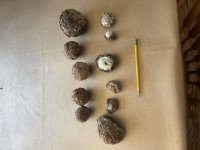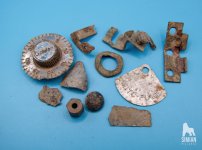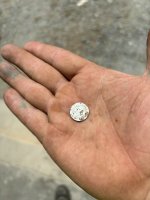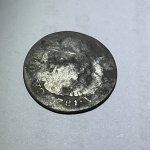You are using an out of date browser. It may not display this or other websites correctly.
You should upgrade or use an alternative browser.
You should upgrade or use an alternative browser.
Strange geological formation, what is it
- Thread starter Rgk50
- Start date
NJearthman
Sr. Member
- Oct 31, 2020
- 354
- 605
- Detector(s) used
- AT PRO, EQUINOX 600
- Primary Interest:
- All Treasure Hunting
Pretty wild….a location town ,county and state could help narrow down an ID. Outcrop looks to be loaded with sphere-like concretions similar to moqui balls but not as smooth.
https://geology.utah.gov/map-pub/survey-notes/glad-you-asked/moqui-marbles/
https://geology.utah.gov/map-pub/survey-notes/glad-you-asked/moqui-marbles/
Last edited:
Travelinman84
Newbie
- Nov 22, 2021
- 4
- 1
digging. Looks to me like possibly a water or gas infusion in volcanic rock.
- Oct 26, 2004
- 24,072
- 22,828
- 🏆 Honorable Mentions:
- 2
- Detector(s) used
- Minelab Explorer
- Primary Interest:
- Shipwrecks
Reminds me as a kid using a screwdriver and hammer to dislodge garnets from a large rock and collecting them in a Mason jar. Thanks for the memory reminder.
Don.....
Don.....
RTR
Gold Member
- Nov 21, 2017
- 8,180
- 32,469
- Detector(s) used
-
Teknetics Liberator
Falcon MD-20
***********
Blue Bowl
Angus MacKirk sluice
Miller Table
- Primary Interest:
- All Treasure Hunting
Wow that is strange 


NJearthman
Sr. Member
- Oct 31, 2020
- 354
- 605
- Detector(s) used
- AT PRO, EQUINOX 600
- Primary Interest:
- All Treasure Hunting
This outcrop intrigues the hell out of me. I can’t believe there is nothing in the geologic literature of the area that mentions these red sandstone nodules in a black matrix.
NJearthman
Sr. Member
- Oct 31, 2020
- 354
- 605
- Detector(s) used
- AT PRO, EQUINOX 600
- Primary Interest:
- All Treasure Hunting
I asked the Idaho Geological Survey about this outcrop -here is their response:
It looks like you have some well-developed spherulites that formed in what is almost certainly a rhyolite. These form when the original glass recrystallizes as feldspar and quartz. When hollow, the term lithophysae is used, and that is how you get thunder eggs, the Spencer opal deposits, and geodes. Those with the crystals in the center are geodes. Hot fluids percolating through the rhyolite after the spherulites form carry the silica needed to form opal, agate, and quartz crystals.
These spherulites are probably from one of the many rhyolitic ash-flow tuffs in the region that formed in massive eruptions as a result of the passage of the Yellowstone hot spot. Rhyolite tuffs form when hot ash lands and welds back together. If that happens quickly enough, glass forms. It is that glass that will sometimes recrystallize.
An old USGS geologic map that shows the distribution of the various rhyolites is available here: https://ngmdb.usgs.gov/Prodesc/proddesc_9085.htm
It looks like you have some well-developed spherulites that formed in what is almost certainly a rhyolite. These form when the original glass recrystallizes as feldspar and quartz. When hollow, the term lithophysae is used, and that is how you get thunder eggs, the Spencer opal deposits, and geodes. Those with the crystals in the center are geodes. Hot fluids percolating through the rhyolite after the spherulites form carry the silica needed to form opal, agate, and quartz crystals.
These spherulites are probably from one of the many rhyolitic ash-flow tuffs in the region that formed in massive eruptions as a result of the passage of the Yellowstone hot spot. Rhyolite tuffs form when hot ash lands and welds back together. If that happens quickly enough, glass forms. It is that glass that will sometimes recrystallize.
An old USGS geologic map that shows the distribution of the various rhyolites is available here: https://ngmdb.usgs.gov/Prodesc/proddesc_9085.htm
pspr
Jr. Member
- May 24, 2012
- 41
- 32
- Detector(s) used
-
Manticore
Explorer XS
- Primary Interest:
- Other
Petrified alien excrement left many thousands of years ago.
Top Member Reactions
-
 2605
2605 -
 1182
1182 -
 1077
1077 -
 888
888 -
 862
862 -
 835
835 -
 793
793 -
 675
675 -
 645
645 -
 615
615 -
 497
497 -
 476
476 -
 472
472 -
 472
472 -
 464
464 -
 430
430 -
 403
403 -
O
396
-
 387
387 -
 385
385
Users who are viewing this thread
Total: 2 (members: 0, guests: 2)








